Comparative Analysis of Tourism Strategies in Kenya and South Africa
VerifiedAdded on 2022/10/03
|25
|7074
|24
Report
AI Summary
This report provides a comparative analysis of the evolution of tourism strategies in Kenya and South Africa. It examines the historical development of tourism policies in both countries, focusing on key aspects such as economic development, information gathering, innovation, marketing, education, rural development, travel facilitation, product variation, equality, diversity, and sustainability. The analysis highlights the main objectives of each country's policies, comparing their approaches to marketing, technology, and community development. The report also includes recommendations for improving tourism strategies, addressing issues like seasonality and risk assessment. The study emphasizes the importance of mutual learning and policy examination for the growth of the tourism industry in both nations, with a focus on economic contributions, job creation, and the integration of local communities. The report also looks at the impact of policy on economic development and includes an executive summary, table of contents, references and an author’s note.
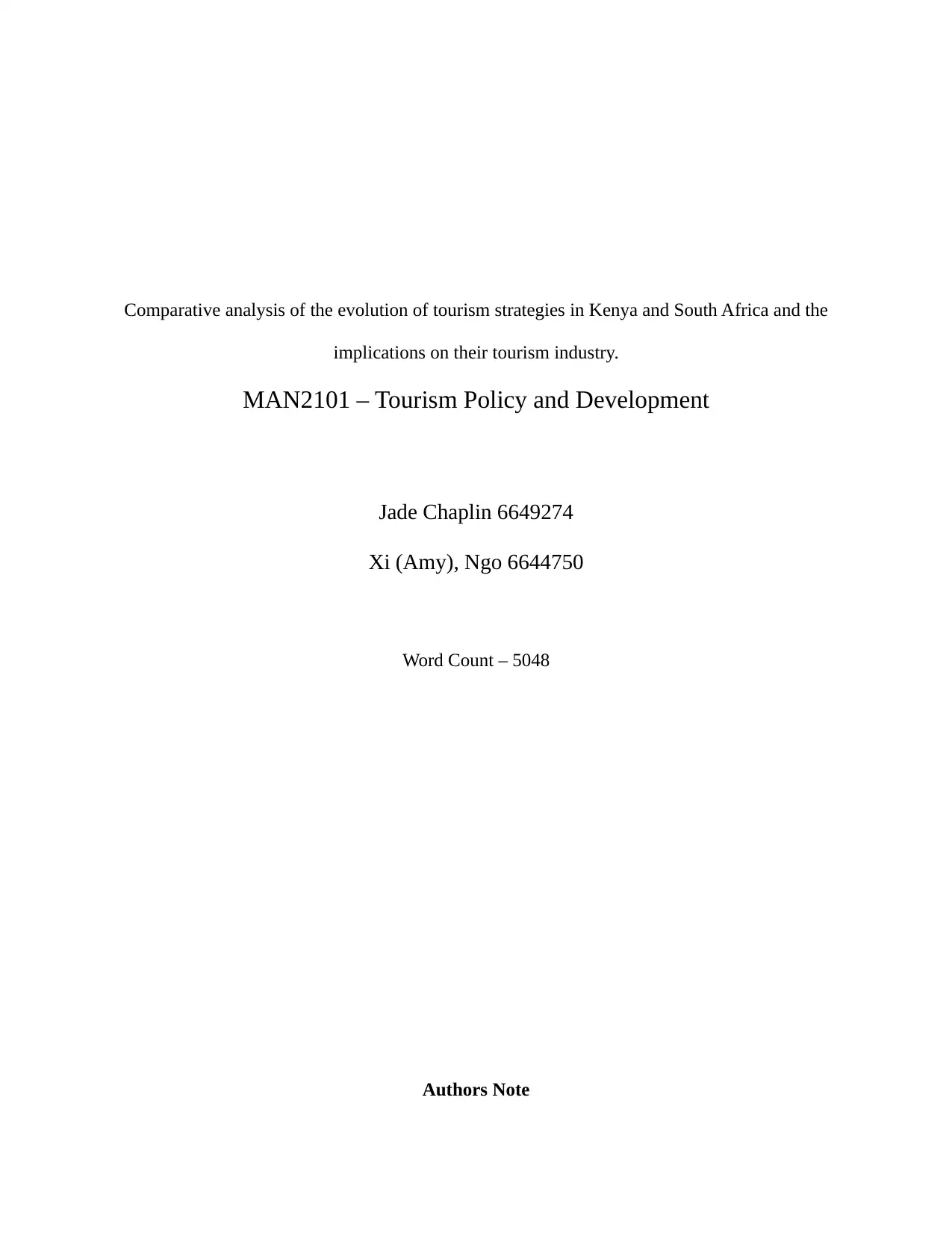
Comparative analysis of the evolution of tourism strategies in Kenya and South Africa and the
implications on their tourism industry.
MAN2101 – Tourism Policy and Development
Jade Chaplin 6649274
Xi (Amy), Ngo 6644750
Word Count – 5048
Authors Note
implications on their tourism industry.
MAN2101 – Tourism Policy and Development
Jade Chaplin 6649274
Xi (Amy), Ngo 6644750
Word Count – 5048
Authors Note
Paraphrase This Document
Need a fresh take? Get an instant paraphrase of this document with our AI Paraphraser
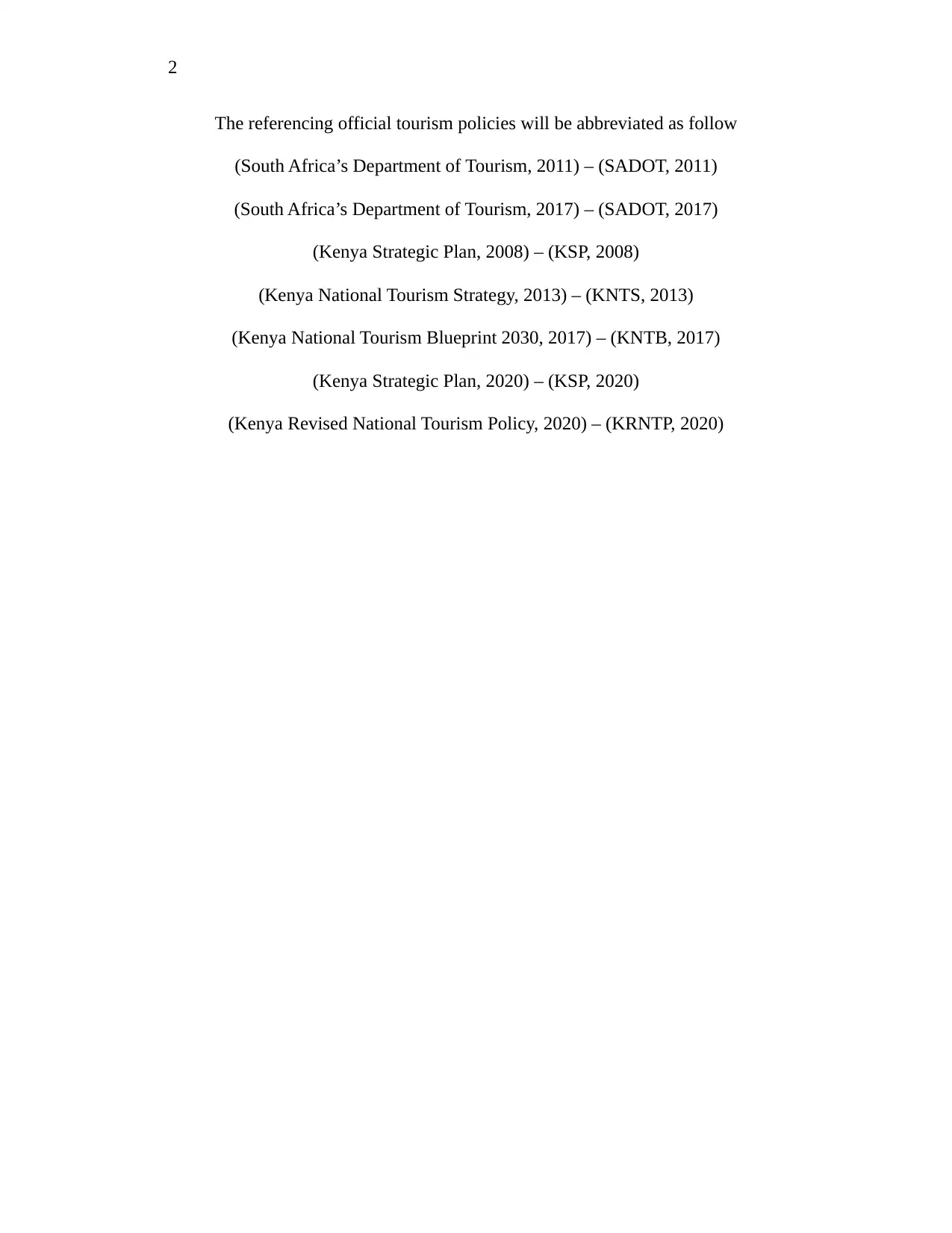
2
The referencing official tourism policies will be abbreviated as follow
(South Africa’s Department of Tourism, 2011) – (SADOT, 2011)
(South Africa’s Department of Tourism, 2017) – (SADOT, 2017)
(Kenya Strategic Plan, 2008) – (KSP, 2008)
(Kenya National Tourism Strategy, 2013) – (KNTS, 2013)
(Kenya National Tourism Blueprint 2030, 2017) – (KNTB, 2017)
(Kenya Strategic Plan, 2020) – (KSP, 2020)
(Kenya Revised National Tourism Policy, 2020) – (KRNTP, 2020)
The referencing official tourism policies will be abbreviated as follow
(South Africa’s Department of Tourism, 2011) – (SADOT, 2011)
(South Africa’s Department of Tourism, 2017) – (SADOT, 2017)
(Kenya Strategic Plan, 2008) – (KSP, 2008)
(Kenya National Tourism Strategy, 2013) – (KNTS, 2013)
(Kenya National Tourism Blueprint 2030, 2017) – (KNTB, 2017)
(Kenya Strategic Plan, 2020) – (KSP, 2020)
(Kenya Revised National Tourism Policy, 2020) – (KRNTP, 2020)
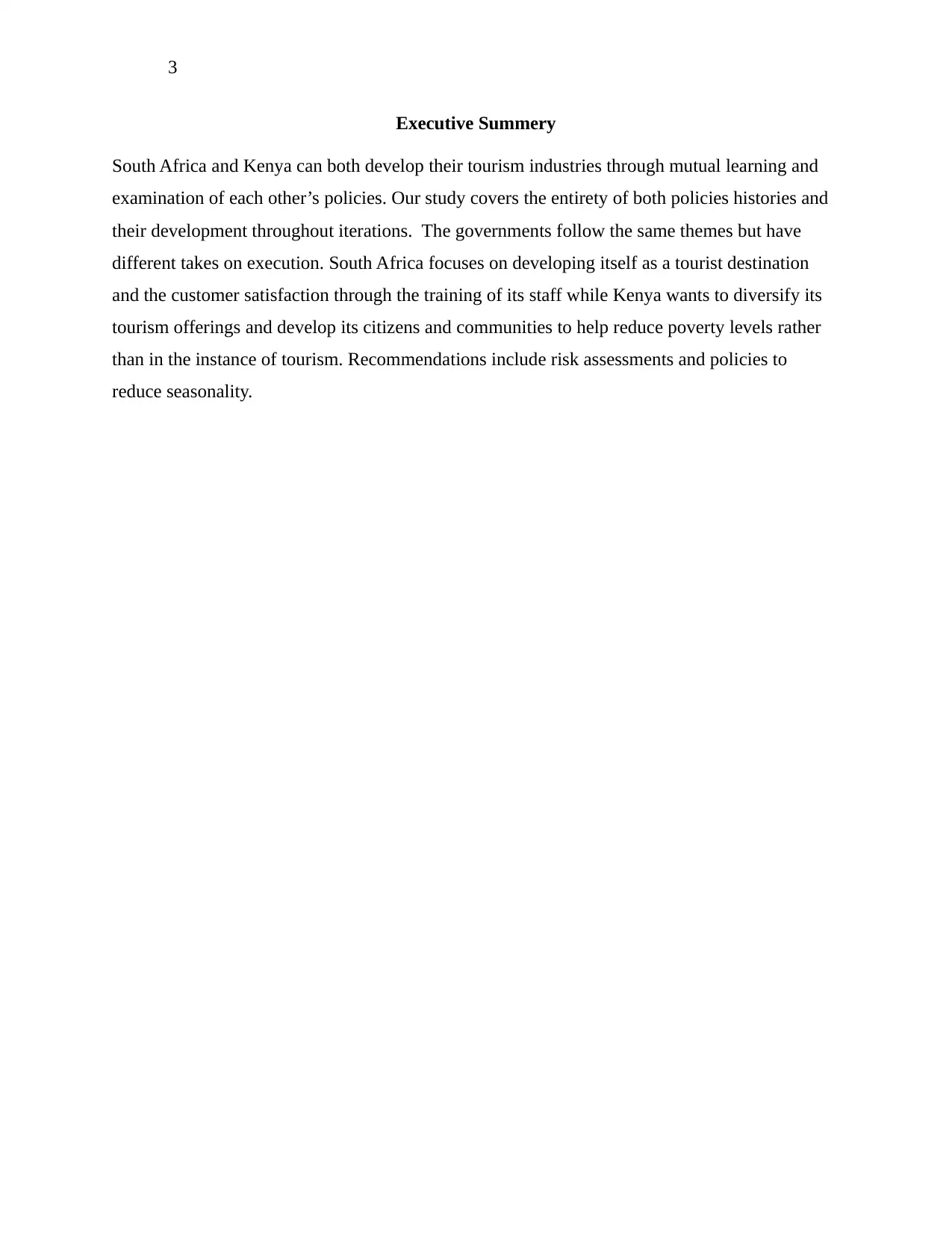
3
Executive Summery
South Africa and Kenya can both develop their tourism industries through mutual learning and
examination of each other’s policies. Our study covers the entirety of both policies histories and
their development throughout iterations. The governments follow the same themes but have
different takes on execution. South Africa focuses on developing itself as a tourist destination
and the customer satisfaction through the training of its staff while Kenya wants to diversify its
tourism offerings and develop its citizens and communities to help reduce poverty levels rather
than in the instance of tourism. Recommendations include risk assessments and policies to
reduce seasonality.
Executive Summery
South Africa and Kenya can both develop their tourism industries through mutual learning and
examination of each other’s policies. Our study covers the entirety of both policies histories and
their development throughout iterations. The governments follow the same themes but have
different takes on execution. South Africa focuses on developing itself as a tourist destination
and the customer satisfaction through the training of its staff while Kenya wants to diversify its
tourism offerings and develop its citizens and communities to help reduce poverty levels rather
than in the instance of tourism. Recommendations include risk assessments and policies to
reduce seasonality.
⊘ This is a preview!⊘
Do you want full access?
Subscribe today to unlock all pages.

Trusted by 1+ million students worldwide
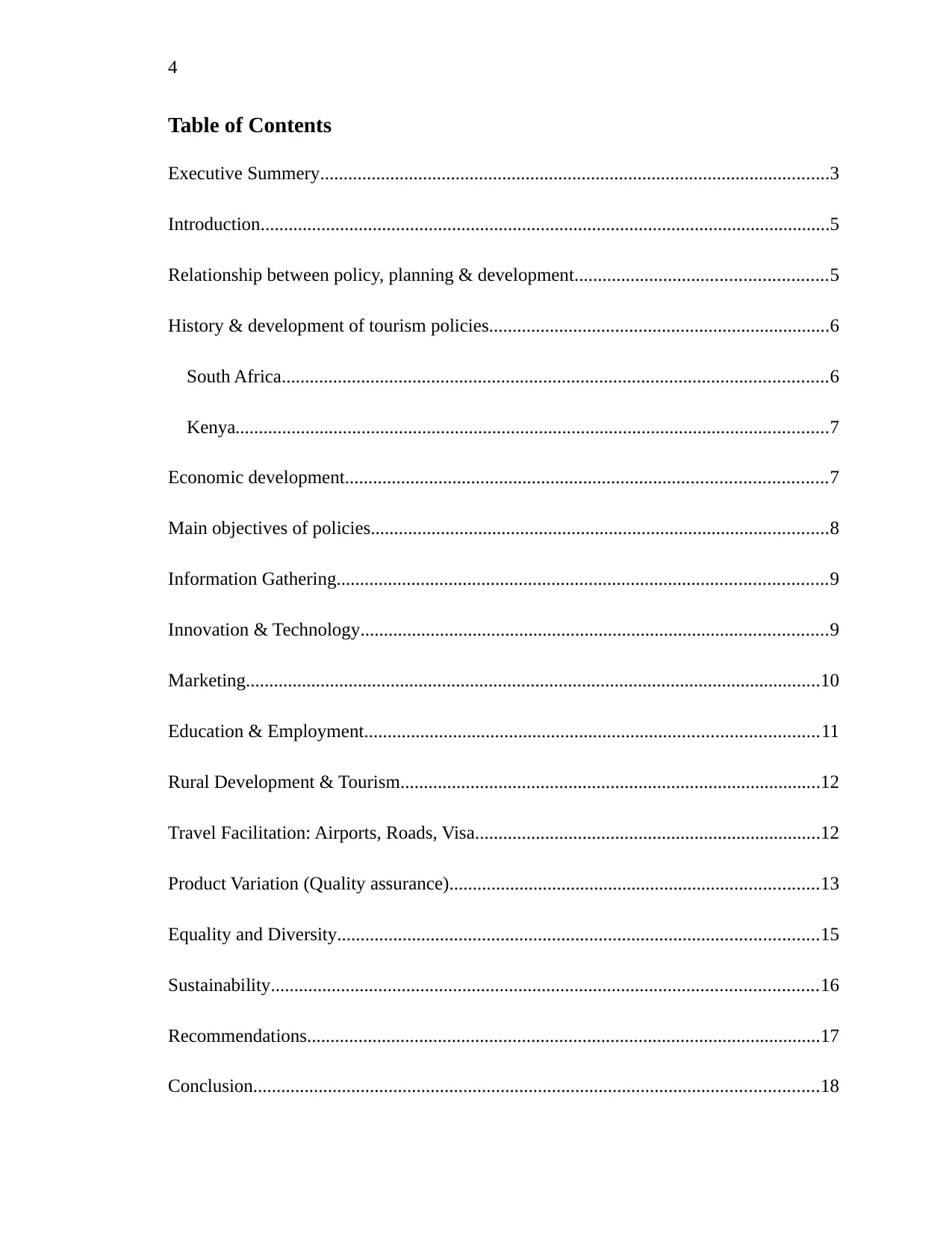
4
Table of Contents
Executive Summery.............................................................................................................3
Introduction..........................................................................................................................5
Relationship between policy, planning & development......................................................5
History & development of tourism policies.........................................................................6
South Africa.....................................................................................................................6
Kenya...............................................................................................................................7
Economic development.......................................................................................................7
Main objectives of policies..................................................................................................8
Information Gathering.........................................................................................................9
Innovation & Technology....................................................................................................9
Marketing...........................................................................................................................10
Education & Employment.................................................................................................11
Rural Development & Tourism..........................................................................................12
Travel Facilitation: Airports, Roads, Visa..........................................................................12
Product Variation (Quality assurance)...............................................................................13
Equality and Diversity.......................................................................................................15
Sustainability.....................................................................................................................16
Recommendations..............................................................................................................17
Conclusion.........................................................................................................................18
Table of Contents
Executive Summery.............................................................................................................3
Introduction..........................................................................................................................5
Relationship between policy, planning & development......................................................5
History & development of tourism policies.........................................................................6
South Africa.....................................................................................................................6
Kenya...............................................................................................................................7
Economic development.......................................................................................................7
Main objectives of policies..................................................................................................8
Information Gathering.........................................................................................................9
Innovation & Technology....................................................................................................9
Marketing...........................................................................................................................10
Education & Employment.................................................................................................11
Rural Development & Tourism..........................................................................................12
Travel Facilitation: Airports, Roads, Visa..........................................................................12
Product Variation (Quality assurance)...............................................................................13
Equality and Diversity.......................................................................................................15
Sustainability.....................................................................................................................16
Recommendations..............................................................................................................17
Conclusion.........................................................................................................................18
Paraphrase This Document
Need a fresh take? Get an instant paraphrase of this document with our AI Paraphraser
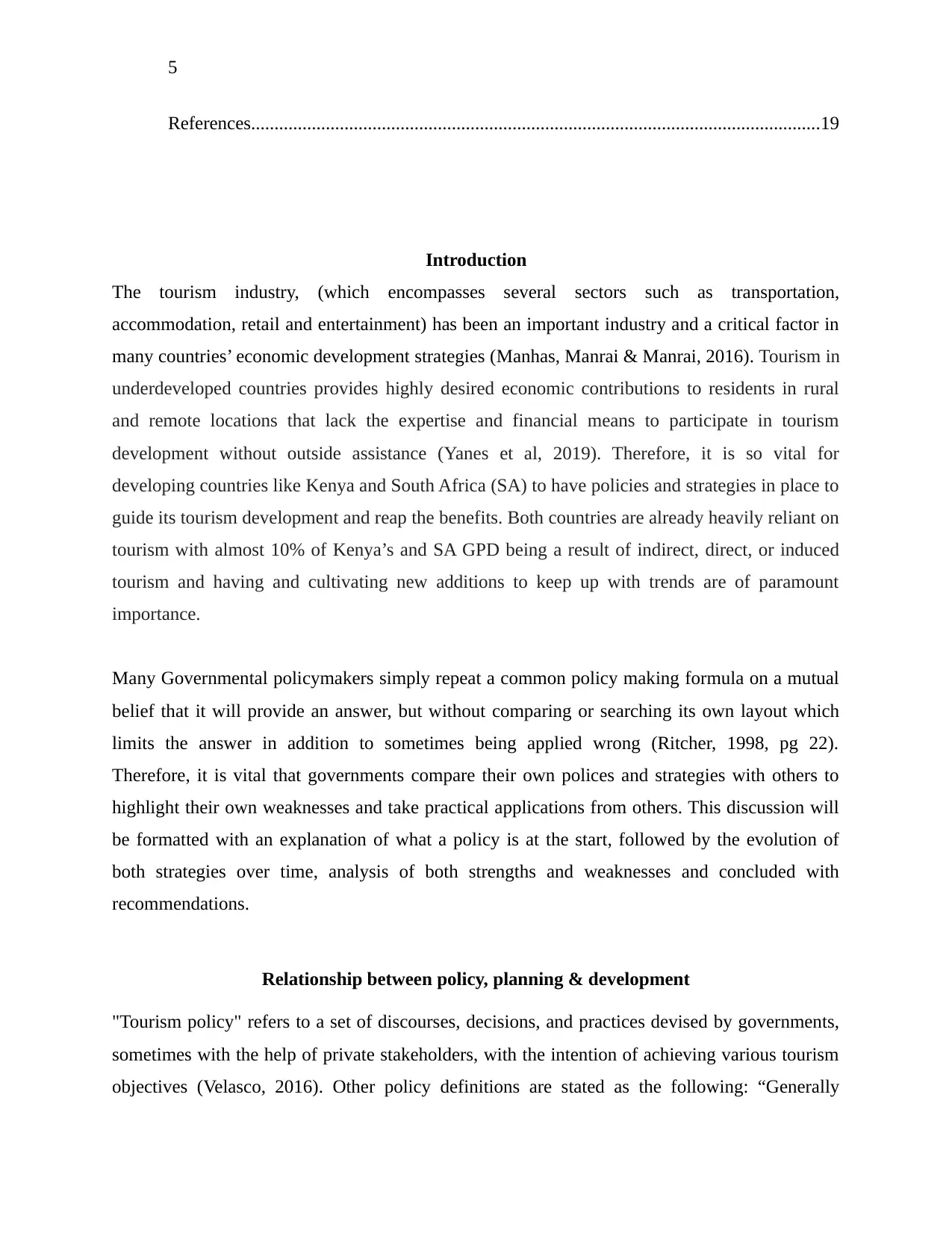
5
References..........................................................................................................................19
Introduction
The tourism industry, (which encompasses several sectors such as transportation,
accommodation, retail and entertainment) has been an important industry and a critical factor in
many countries’ economic development strategies (Manhas, Manrai & Manrai, 2016). Tourism in
underdeveloped countries provides highly desired economic contributions to residents in rural
and remote locations that lack the expertise and financial means to participate in tourism
development without outside assistance (Yanes et al, 2019). Therefore, it is so vital for
developing countries like Kenya and South Africa (SA) to have policies and strategies in place to
guide its tourism development and reap the benefits. Both countries are already heavily reliant on
tourism with almost 10% of Kenya’s and SA GPD being a result of indirect, direct, or induced
tourism and having and cultivating new additions to keep up with trends are of paramount
importance.
Many Governmental policymakers simply repeat a common policy making formula on a mutual
belief that it will provide an answer, but without comparing or searching its own layout which
limits the answer in addition to sometimes being applied wrong (Ritcher, 1998, pg 22).
Therefore, it is vital that governments compare their own polices and strategies with others to
highlight their own weaknesses and take practical applications from others. This discussion will
be formatted with an explanation of what a policy is at the start, followed by the evolution of
both strategies over time, analysis of both strengths and weaknesses and concluded with
recommendations.
Relationship between policy, planning & development
"Tourism policy" refers to a set of discourses, decisions, and practices devised by governments,
sometimes with the help of private stakeholders, with the intention of achieving various tourism
objectives (Velasco, 2016). Other policy definitions are stated as the following: “Generally
References..........................................................................................................................19
Introduction
The tourism industry, (which encompasses several sectors such as transportation,
accommodation, retail and entertainment) has been an important industry and a critical factor in
many countries’ economic development strategies (Manhas, Manrai & Manrai, 2016). Tourism in
underdeveloped countries provides highly desired economic contributions to residents in rural
and remote locations that lack the expertise and financial means to participate in tourism
development without outside assistance (Yanes et al, 2019). Therefore, it is so vital for
developing countries like Kenya and South Africa (SA) to have policies and strategies in place to
guide its tourism development and reap the benefits. Both countries are already heavily reliant on
tourism with almost 10% of Kenya’s and SA GPD being a result of indirect, direct, or induced
tourism and having and cultivating new additions to keep up with trends are of paramount
importance.
Many Governmental policymakers simply repeat a common policy making formula on a mutual
belief that it will provide an answer, but without comparing or searching its own layout which
limits the answer in addition to sometimes being applied wrong (Ritcher, 1998, pg 22).
Therefore, it is vital that governments compare their own polices and strategies with others to
highlight their own weaknesses and take practical applications from others. This discussion will
be formatted with an explanation of what a policy is at the start, followed by the evolution of
both strategies over time, analysis of both strengths and weaknesses and concluded with
recommendations.
Relationship between policy, planning & development
"Tourism policy" refers to a set of discourses, decisions, and practices devised by governments,
sometimes with the help of private stakeholders, with the intention of achieving various tourism
objectives (Velasco, 2016). Other policy definitions are stated as the following: “Generally
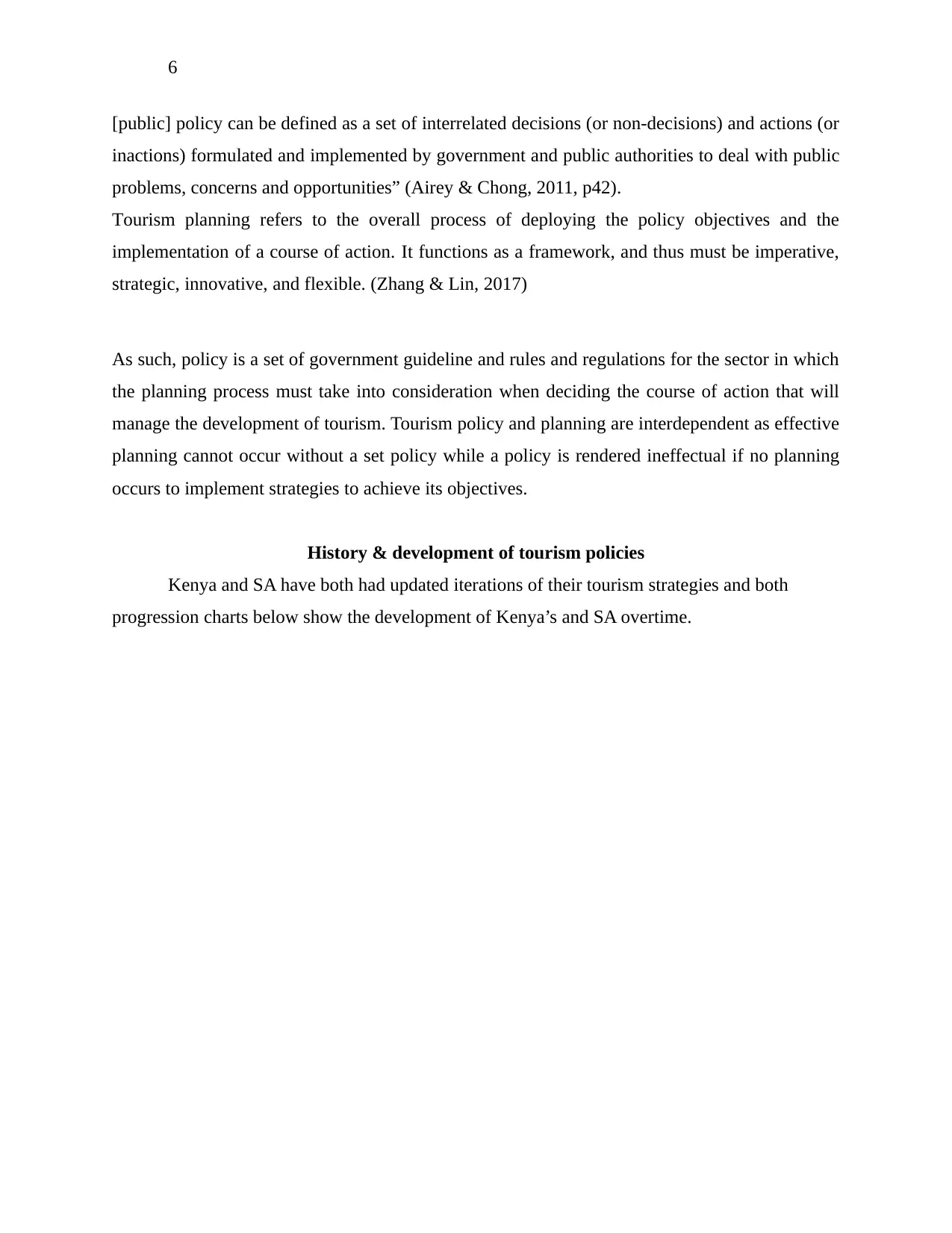
6
[public] policy can be defined as a set of interrelated decisions (or non-decisions) and actions (or
inactions) formulated and implemented by government and public authorities to deal with public
problems, concerns and opportunities” (Airey & Chong, 2011, p42).
Tourism planning refers to the overall process of deploying the policy objectives and the
implementation of a course of action. It functions as a framework, and thus must be imperative,
strategic, innovative, and flexible. (Zhang & Lin, 2017)
As such, policy is a set of government guideline and rules and regulations for the sector in which
the planning process must take into consideration when deciding the course of action that will
manage the development of tourism. Tourism policy and planning are interdependent as effective
planning cannot occur without a set policy while a policy is rendered ineffectual if no planning
occurs to implement strategies to achieve its objectives.
History & development of tourism policies
Kenya and SA have both had updated iterations of their tourism strategies and both
progression charts below show the development of Kenya’s and SA overtime.
[public] policy can be defined as a set of interrelated decisions (or non-decisions) and actions (or
inactions) formulated and implemented by government and public authorities to deal with public
problems, concerns and opportunities” (Airey & Chong, 2011, p42).
Tourism planning refers to the overall process of deploying the policy objectives and the
implementation of a course of action. It functions as a framework, and thus must be imperative,
strategic, innovative, and flexible. (Zhang & Lin, 2017)
As such, policy is a set of government guideline and rules and regulations for the sector in which
the planning process must take into consideration when deciding the course of action that will
manage the development of tourism. Tourism policy and planning are interdependent as effective
planning cannot occur without a set policy while a policy is rendered ineffectual if no planning
occurs to implement strategies to achieve its objectives.
History & development of tourism policies
Kenya and SA have both had updated iterations of their tourism strategies and both
progression charts below show the development of Kenya’s and SA overtime.
⊘ This is a preview!⊘
Do you want full access?
Subscribe today to unlock all pages.

Trusted by 1+ million students worldwide
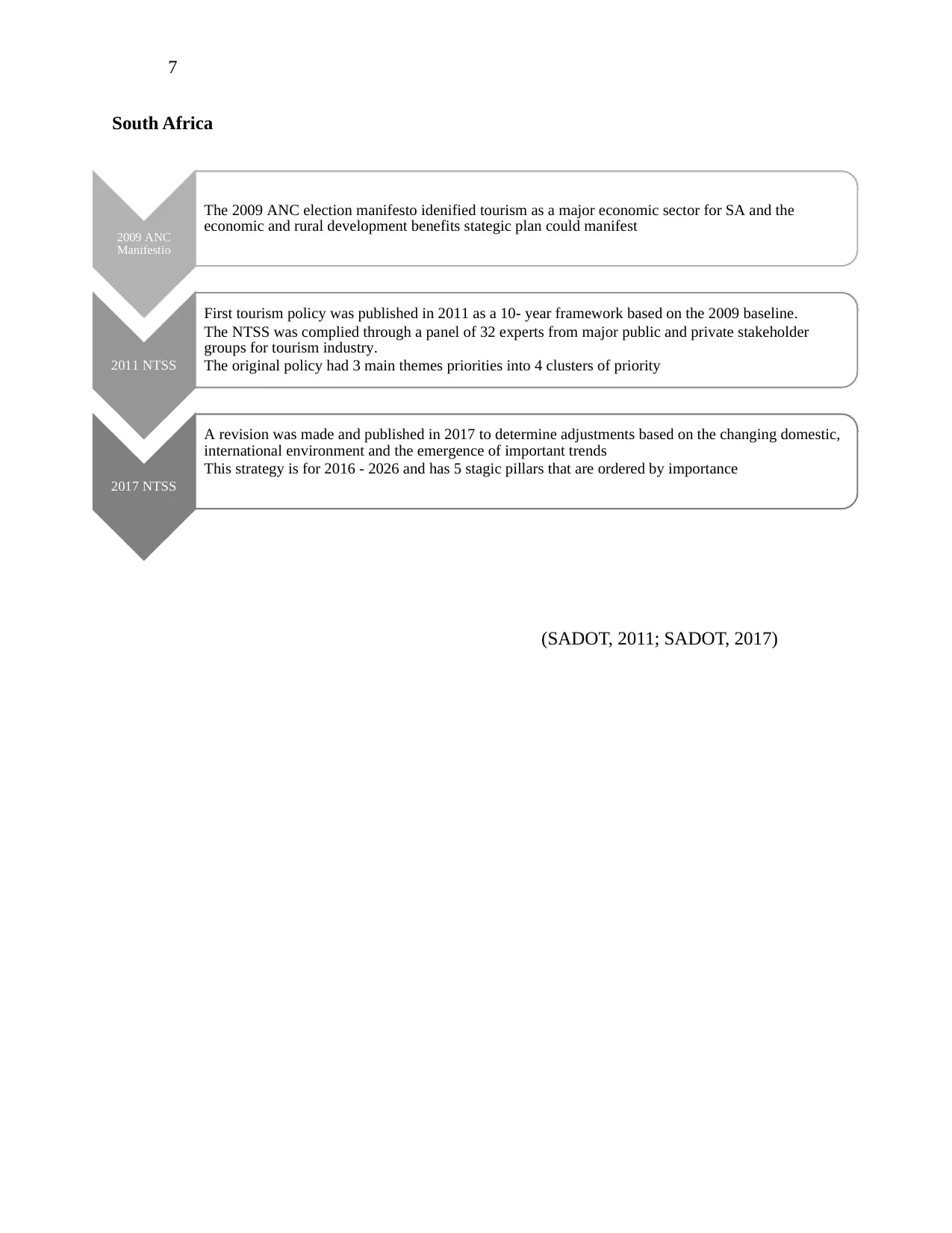
7
South Africa
(SADOT, 2011; SADOT, 2017)
2009 ANC
Manifestio
The 2009 ANC election manifesto idenified tourism as a major economic sector for SA and the
economic and rural development benefits stategic plan could manifest
2011 NTSS
First tourism policy was published in 2011 as a 10- year framework based on the 2009 baseline.
The NTSS was complied through a panel of 32 experts from major public and private stakeholder
groups for tourism industry.
The original policy had 3 main themes priorities into 4 clusters of priority
2017 NTSS
A revision was made and published in 2017 to determine adjustments based on the changing domestic,
international environment and the emergence of important trends
This strategy is for 2016 - 2026 and has 5 stagic pillars that are ordered by importance
South Africa
(SADOT, 2011; SADOT, 2017)
2009 ANC
Manifestio
The 2009 ANC election manifesto idenified tourism as a major economic sector for SA and the
economic and rural development benefits stategic plan could manifest
2011 NTSS
First tourism policy was published in 2011 as a 10- year framework based on the 2009 baseline.
The NTSS was complied through a panel of 32 experts from major public and private stakeholder
groups for tourism industry.
The original policy had 3 main themes priorities into 4 clusters of priority
2017 NTSS
A revision was made and published in 2017 to determine adjustments based on the changing domestic,
international environment and the emergence of important trends
This strategy is for 2016 - 2026 and has 5 stagic pillars that are ordered by importance
Paraphrase This Document
Need a fresh take? Get an instant paraphrase of this document with our AI Paraphraser
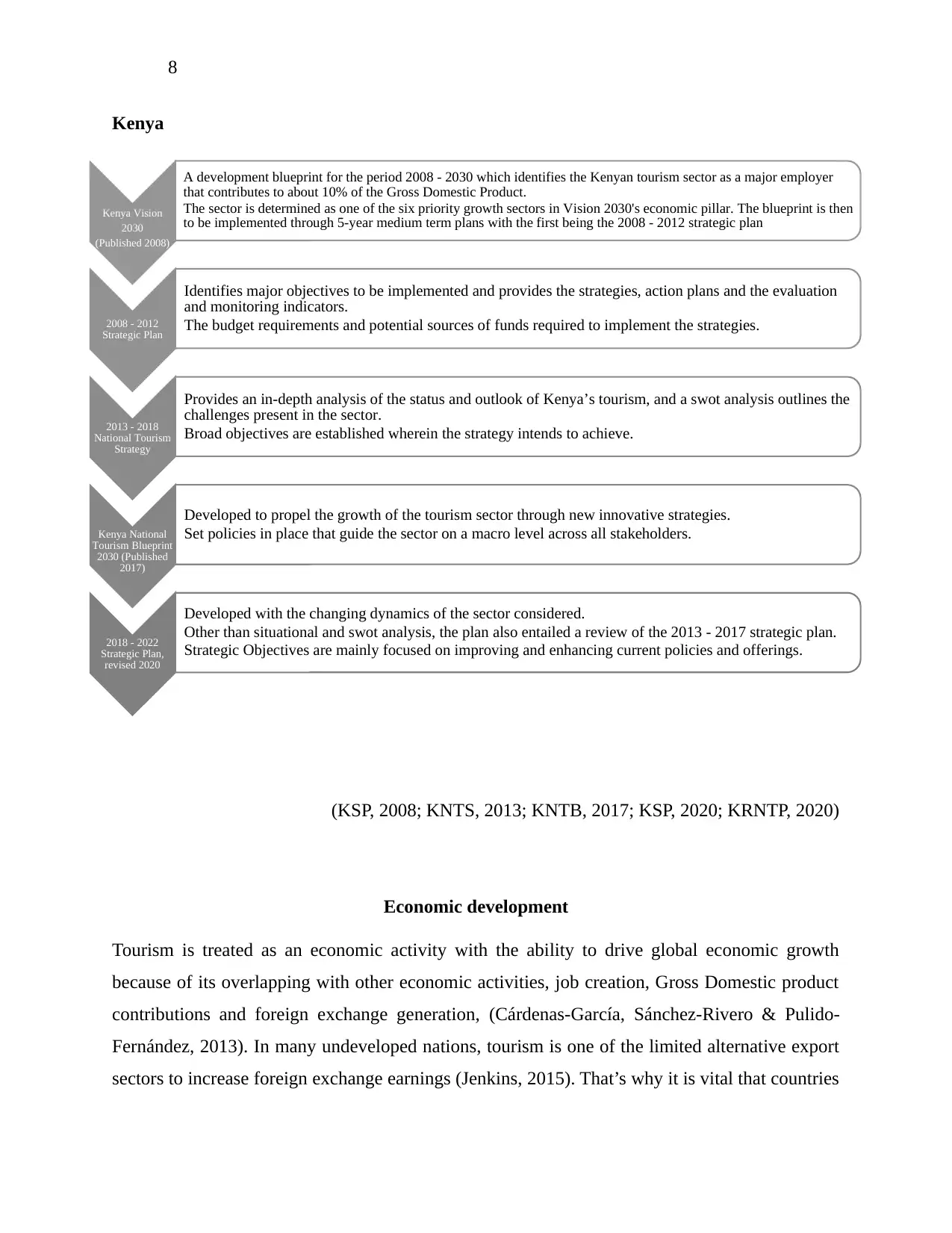
8
Kenya
(KSP, 2008; KNTS, 2013; KNTB, 2017; KSP, 2020; KRNTP, 2020)
Economic development
Tourism is treated as an economic activity with the ability to drive global economic growth
because of its overlapping with other economic activities, job creation, Gross Domestic product
contributions and foreign exchange generation, (Cárdenas-García, Sánchez-Rivero & Pulido-
Fernández, 2013). In many undeveloped nations, tourism is one of the limited alternative export
sectors to increase foreign exchange earnings (Jenkins, 2015). That’s why it is vital that countries
Kenya Vision
2030
(Published 2008)
A development blueprint for the period 2008 - 2030 which identifies the Kenyan tourism sector as a major employer
that contributes to about 10% of the Gross Domestic Product.
The sector is determined as one of the six priority growth sectors in Vision 2030's economic pillar. The blueprint is then
to be implemented through 5-year medium term plans with the first being the 2008 - 2012 strategic plan
2008 - 2012
Strategic Plan
Identifies major objectives to be implemented and provides the strategies, action plans and the evaluation
and monitoring indicators.
The budget requirements and potential sources of funds required to implement the strategies.
2013 - 2018
National Tourism
Strategy
Provides an in-depth analysis of the status and outlook of Kenya’s tourism, and a swot analysis outlines the
challenges present in the sector.
Broad objectives are established wherein the strategy intends to achieve.
Kenya National
Tourism Blueprint
2030 (Published
2017)
Developed to propel the growth of the tourism sector through new innovative strategies.
Set policies in place that guide the sector on a macro level across all stakeholders.
2018 - 2022
Strategic Plan,
revised 2020
Developed with the changing dynamics of the sector considered.
Other than situational and swot analysis, the plan also entailed a review of the 2013 - 2017 strategic plan.
Strategic Objectives are mainly focused on improving and enhancing current policies and offerings.
Kenya
(KSP, 2008; KNTS, 2013; KNTB, 2017; KSP, 2020; KRNTP, 2020)
Economic development
Tourism is treated as an economic activity with the ability to drive global economic growth
because of its overlapping with other economic activities, job creation, Gross Domestic product
contributions and foreign exchange generation, (Cárdenas-García, Sánchez-Rivero & Pulido-
Fernández, 2013). In many undeveloped nations, tourism is one of the limited alternative export
sectors to increase foreign exchange earnings (Jenkins, 2015). That’s why it is vital that countries
Kenya Vision
2030
(Published 2008)
A development blueprint for the period 2008 - 2030 which identifies the Kenyan tourism sector as a major employer
that contributes to about 10% of the Gross Domestic Product.
The sector is determined as one of the six priority growth sectors in Vision 2030's economic pillar. The blueprint is then
to be implemented through 5-year medium term plans with the first being the 2008 - 2012 strategic plan
2008 - 2012
Strategic Plan
Identifies major objectives to be implemented and provides the strategies, action plans and the evaluation
and monitoring indicators.
The budget requirements and potential sources of funds required to implement the strategies.
2013 - 2018
National Tourism
Strategy
Provides an in-depth analysis of the status and outlook of Kenya’s tourism, and a swot analysis outlines the
challenges present in the sector.
Broad objectives are established wherein the strategy intends to achieve.
Kenya National
Tourism Blueprint
2030 (Published
2017)
Developed to propel the growth of the tourism sector through new innovative strategies.
Set policies in place that guide the sector on a macro level across all stakeholders.
2018 - 2022
Strategic Plan,
revised 2020
Developed with the changing dynamics of the sector considered.
Other than situational and swot analysis, the plan also entailed a review of the 2013 - 2017 strategic plan.
Strategic Objectives are mainly focused on improving and enhancing current policies and offerings.
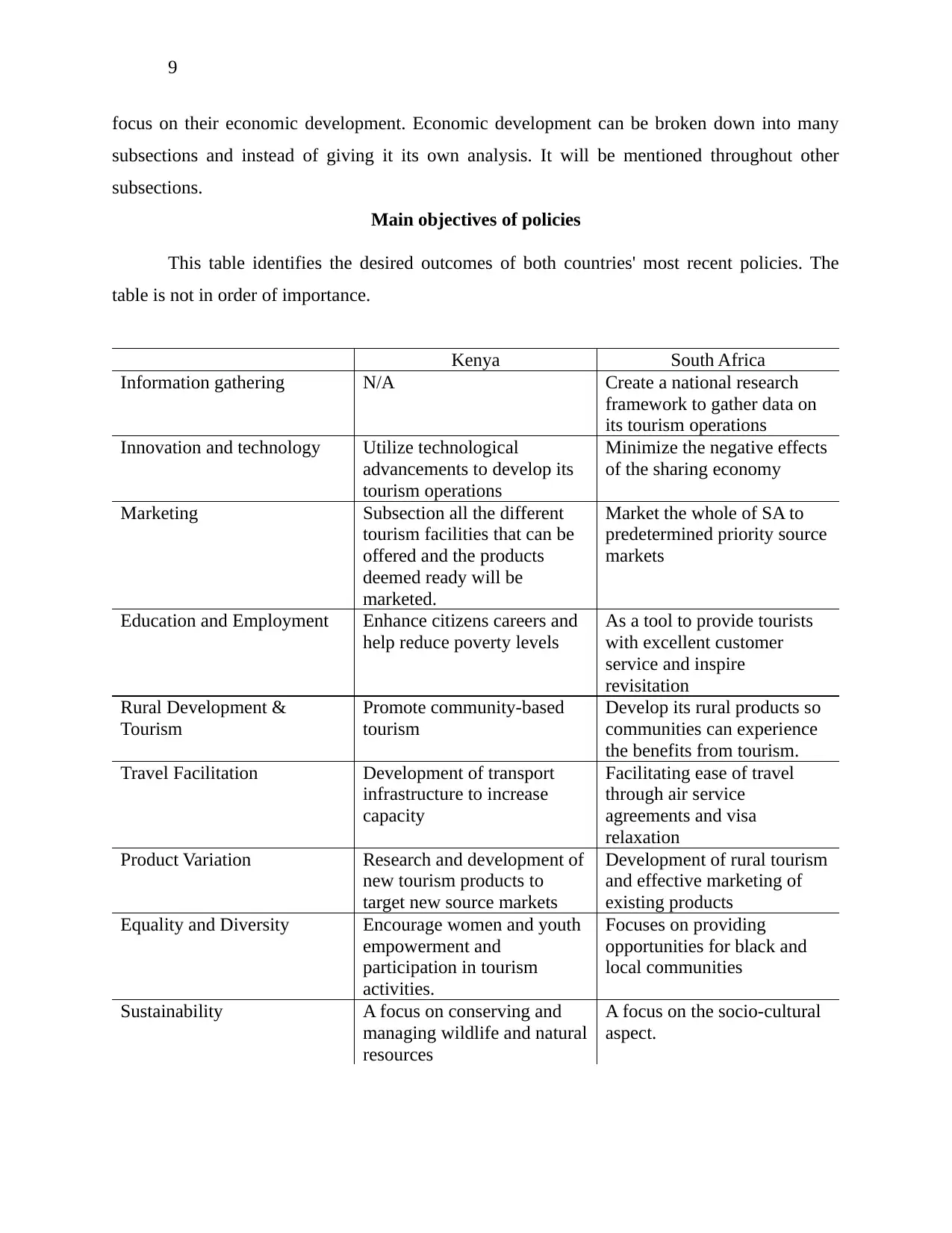
9
focus on their economic development. Economic development can be broken down into many
subsections and instead of giving it its own analysis. It will be mentioned throughout other
subsections.
Main objectives of policies
This table identifies the desired outcomes of both countries' most recent policies. The
table is not in order of importance.
Kenya South Africa
Information gathering N/A Create a national research
framework to gather data on
its tourism operations
Innovation and technology Utilize technological
advancements to develop its
tourism operations
Minimize the negative effects
of the sharing economy
Marketing Subsection all the different
tourism facilities that can be
offered and the products
deemed ready will be
marketed.
Market the whole of SA to
predetermined priority source
markets
Education and Employment Enhance citizens careers and
help reduce poverty levels
As a tool to provide tourists
with excellent customer
service and inspire
revisitation
Rural Development &
Tourism
Promote community-based
tourism
Develop its rural products so
communities can experience
the benefits from tourism.
Travel Facilitation Development of transport
infrastructure to increase
capacity
Facilitating ease of travel
through air service
agreements and visa
relaxation
Product Variation Research and development of
new tourism products to
target new source markets
Development of rural tourism
and effective marketing of
existing products
Equality and Diversity Encourage women and youth
empowerment and
participation in tourism
activities.
Focuses on providing
opportunities for black and
local communities
Sustainability A focus on conserving and
managing wildlife and natural
resources
A focus on the socio-cultural
aspect.
focus on their economic development. Economic development can be broken down into many
subsections and instead of giving it its own analysis. It will be mentioned throughout other
subsections.
Main objectives of policies
This table identifies the desired outcomes of both countries' most recent policies. The
table is not in order of importance.
Kenya South Africa
Information gathering N/A Create a national research
framework to gather data on
its tourism operations
Innovation and technology Utilize technological
advancements to develop its
tourism operations
Minimize the negative effects
of the sharing economy
Marketing Subsection all the different
tourism facilities that can be
offered and the products
deemed ready will be
marketed.
Market the whole of SA to
predetermined priority source
markets
Education and Employment Enhance citizens careers and
help reduce poverty levels
As a tool to provide tourists
with excellent customer
service and inspire
revisitation
Rural Development &
Tourism
Promote community-based
tourism
Develop its rural products so
communities can experience
the benefits from tourism.
Travel Facilitation Development of transport
infrastructure to increase
capacity
Facilitating ease of travel
through air service
agreements and visa
relaxation
Product Variation Research and development of
new tourism products to
target new source markets
Development of rural tourism
and effective marketing of
existing products
Equality and Diversity Encourage women and youth
empowerment and
participation in tourism
activities.
Focuses on providing
opportunities for black and
local communities
Sustainability A focus on conserving and
managing wildlife and natural
resources
A focus on the socio-cultural
aspect.
⊘ This is a preview!⊘
Do you want full access?
Subscribe today to unlock all pages.

Trusted by 1+ million students worldwide
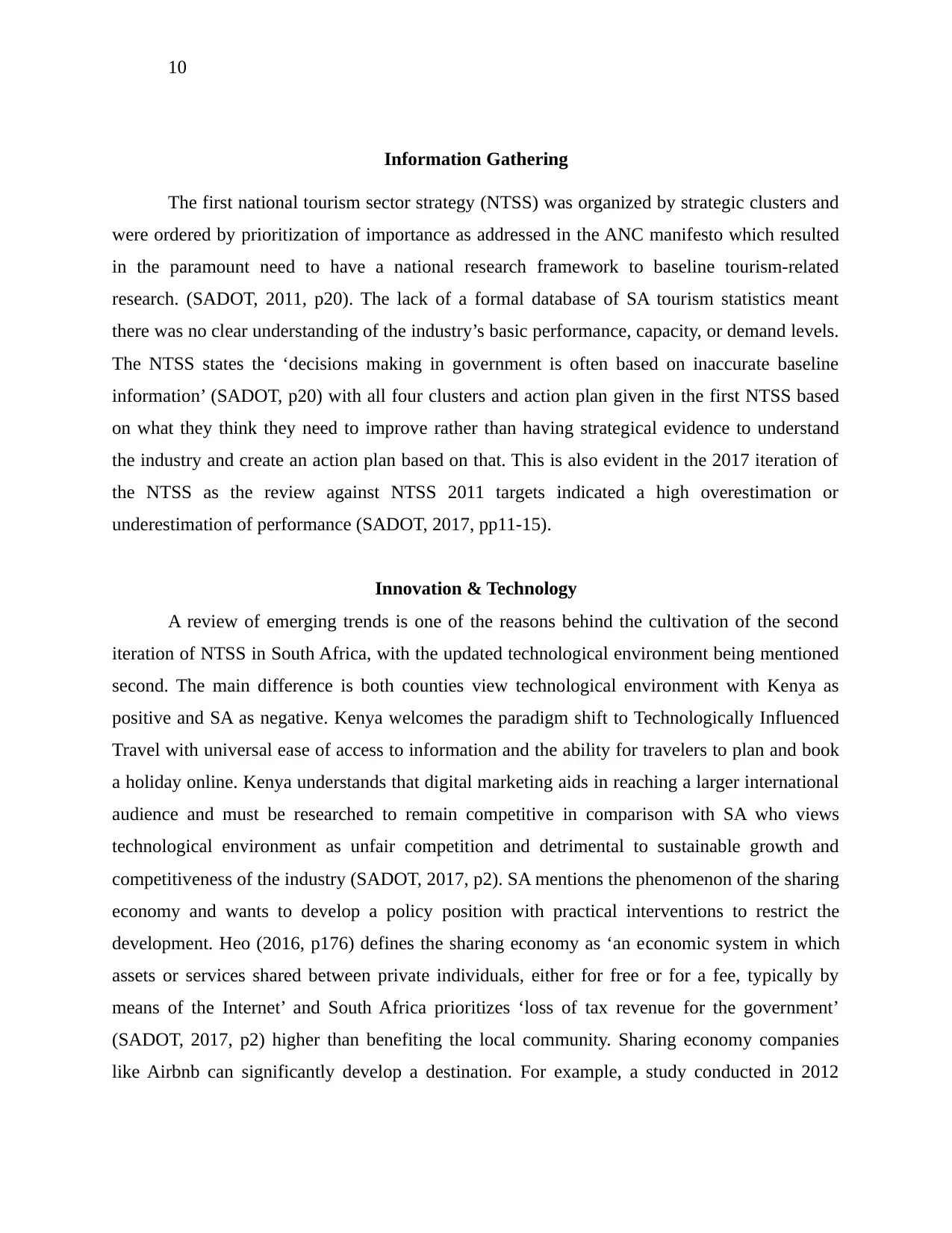
10
Information Gathering
The first national tourism sector strategy (NTSS) was organized by strategic clusters and
were ordered by prioritization of importance as addressed in the ANC manifesto which resulted
in the paramount need to have a national research framework to baseline tourism-related
research. (SADOT, 2011, p20). The lack of a formal database of SA tourism statistics meant
there was no clear understanding of the industry’s basic performance, capacity, or demand levels.
The NTSS states the ‘decisions making in government is often based on inaccurate baseline
information’ (SADOT, p20) with all four clusters and action plan given in the first NTSS based
on what they think they need to improve rather than having strategical evidence to understand
the industry and create an action plan based on that. This is also evident in the 2017 iteration of
the NTSS as the review against NTSS 2011 targets indicated a high overestimation or
underestimation of performance (SADOT, 2017, pp11-15).
Innovation & Technology
A review of emerging trends is one of the reasons behind the cultivation of the second
iteration of NTSS in South Africa, with the updated technological environment being mentioned
second. The main difference is both counties view technological environment with Kenya as
positive and SA as negative. Kenya welcomes the paradigm shift to Technologically Influenced
Travel with universal ease of access to information and the ability for travelers to plan and book
a holiday online. Kenya understands that digital marketing aids in reaching a larger international
audience and must be researched to remain competitive in comparison with SA who views
technological environment as unfair competition and detrimental to sustainable growth and
competitiveness of the industry (SADOT, 2017, p2). SA mentions the phenomenon of the sharing
economy and wants to develop a policy position with practical interventions to restrict the
development. Heo (2016, p176) defines the sharing economy as ‘an economic system in which
assets or services shared between private individuals, either for free or for a fee, typically by
means of the Internet’ and South Africa prioritizes ‘loss of tax revenue for the government’
(SADOT, 2017, p2) higher than benefiting the local community. Sharing economy companies
like Airbnb can significantly develop a destination. For example, a study conducted in 2012
Information Gathering
The first national tourism sector strategy (NTSS) was organized by strategic clusters and
were ordered by prioritization of importance as addressed in the ANC manifesto which resulted
in the paramount need to have a national research framework to baseline tourism-related
research. (SADOT, 2011, p20). The lack of a formal database of SA tourism statistics meant
there was no clear understanding of the industry’s basic performance, capacity, or demand levels.
The NTSS states the ‘decisions making in government is often based on inaccurate baseline
information’ (SADOT, p20) with all four clusters and action plan given in the first NTSS based
on what they think they need to improve rather than having strategical evidence to understand
the industry and create an action plan based on that. This is also evident in the 2017 iteration of
the NTSS as the review against NTSS 2011 targets indicated a high overestimation or
underestimation of performance (SADOT, 2017, pp11-15).
Innovation & Technology
A review of emerging trends is one of the reasons behind the cultivation of the second
iteration of NTSS in South Africa, with the updated technological environment being mentioned
second. The main difference is both counties view technological environment with Kenya as
positive and SA as negative. Kenya welcomes the paradigm shift to Technologically Influenced
Travel with universal ease of access to information and the ability for travelers to plan and book
a holiday online. Kenya understands that digital marketing aids in reaching a larger international
audience and must be researched to remain competitive in comparison with SA who views
technological environment as unfair competition and detrimental to sustainable growth and
competitiveness of the industry (SADOT, 2017, p2). SA mentions the phenomenon of the sharing
economy and wants to develop a policy position with practical interventions to restrict the
development. Heo (2016, p176) defines the sharing economy as ‘an economic system in which
assets or services shared between private individuals, either for free or for a fee, typically by
means of the Internet’ and South Africa prioritizes ‘loss of tax revenue for the government’
(SADOT, 2017, p2) higher than benefiting the local community. Sharing economy companies
like Airbnb can significantly develop a destination. For example, a study conducted in 2012
Paraphrase This Document
Need a fresh take? Get an instant paraphrase of this document with our AI Paraphraser
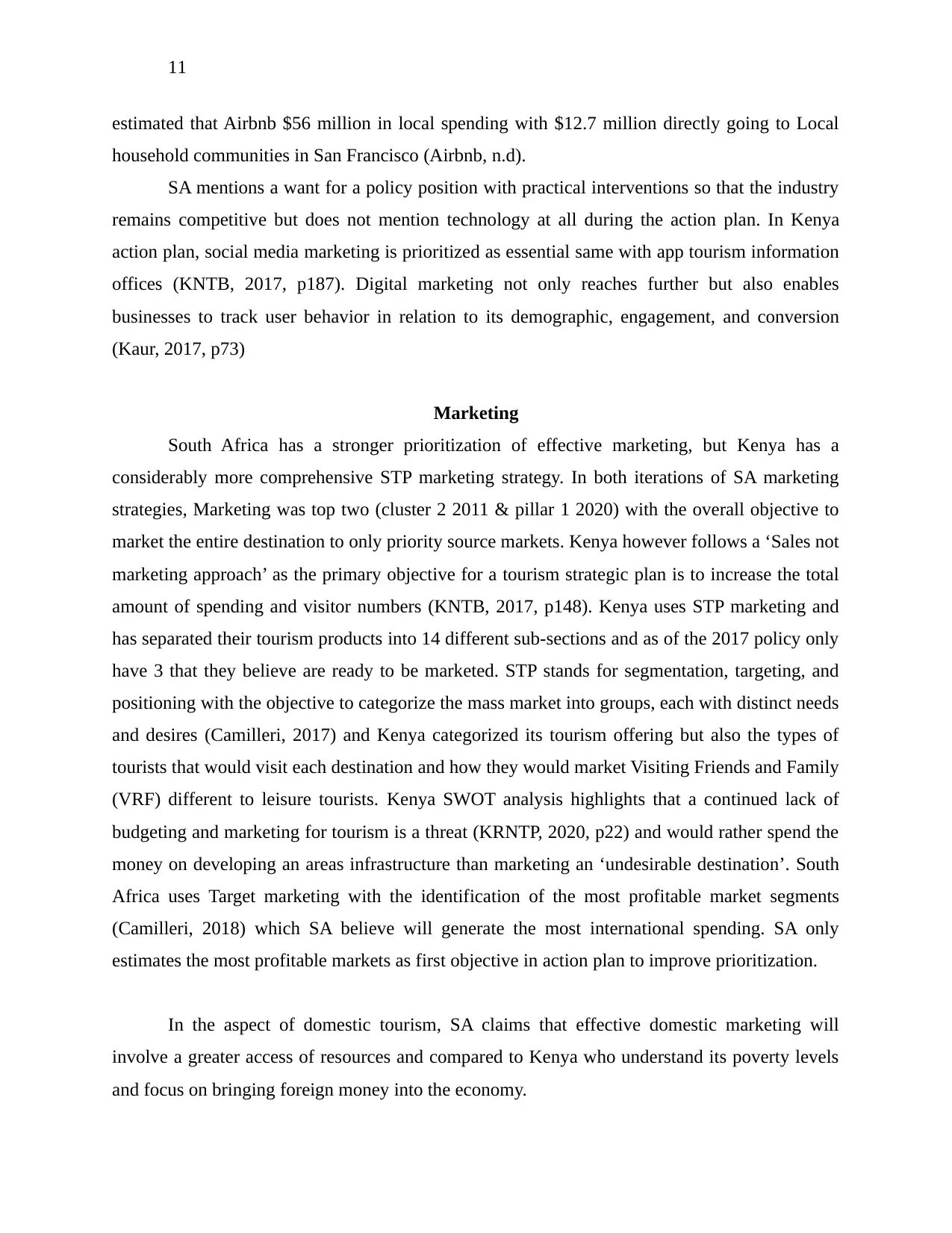
11
estimated that Airbnb $56 million in local spending with $12.7 million directly going to Local
household communities in San Francisco (Airbnb, n.d).
SA mentions a want for a policy position with practical interventions so that the industry
remains competitive but does not mention technology at all during the action plan. In Kenya
action plan, social media marketing is prioritized as essential same with app tourism information
offices (KNTB, 2017, p187). Digital marketing not only reaches further but also enables
businesses to track user behavior in relation to its demographic, engagement, and conversion
(Kaur, 2017, p73)
Marketing
South Africa has a stronger prioritization of effective marketing, but Kenya has a
considerably more comprehensive STP marketing strategy. In both iterations of SA marketing
strategies, Marketing was top two (cluster 2 2011 & pillar 1 2020) with the overall objective to
market the entire destination to only priority source markets. Kenya however follows a ‘Sales not
marketing approach’ as the primary objective for a tourism strategic plan is to increase the total
amount of spending and visitor numbers (KNTB, 2017, p148). Kenya uses STP marketing and
has separated their tourism products into 14 different sub-sections and as of the 2017 policy only
have 3 that they believe are ready to be marketed. STP stands for segmentation, targeting, and
positioning with the objective to categorize the mass market into groups, each with distinct needs
and desires (Camilleri, 2017) and Kenya categorized its tourism offering but also the types of
tourists that would visit each destination and how they would market Visiting Friends and Family
(VRF) different to leisure tourists. Kenya SWOT analysis highlights that a continued lack of
budgeting and marketing for tourism is a threat (KRNTP, 2020, p22) and would rather spend the
money on developing an areas infrastructure than marketing an ‘undesirable destination’. South
Africa uses Target marketing with the identification of the most profitable market segments
(Camilleri, 2018) which SA believe will generate the most international spending. SA only
estimates the most profitable markets as first objective in action plan to improve prioritization.
In the aspect of domestic tourism, SA claims that effective domestic marketing will
involve a greater access of resources and compared to Kenya who understand its poverty levels
and focus on bringing foreign money into the economy.
estimated that Airbnb $56 million in local spending with $12.7 million directly going to Local
household communities in San Francisco (Airbnb, n.d).
SA mentions a want for a policy position with practical interventions so that the industry
remains competitive but does not mention technology at all during the action plan. In Kenya
action plan, social media marketing is prioritized as essential same with app tourism information
offices (KNTB, 2017, p187). Digital marketing not only reaches further but also enables
businesses to track user behavior in relation to its demographic, engagement, and conversion
(Kaur, 2017, p73)
Marketing
South Africa has a stronger prioritization of effective marketing, but Kenya has a
considerably more comprehensive STP marketing strategy. In both iterations of SA marketing
strategies, Marketing was top two (cluster 2 2011 & pillar 1 2020) with the overall objective to
market the entire destination to only priority source markets. Kenya however follows a ‘Sales not
marketing approach’ as the primary objective for a tourism strategic plan is to increase the total
amount of spending and visitor numbers (KNTB, 2017, p148). Kenya uses STP marketing and
has separated their tourism products into 14 different sub-sections and as of the 2017 policy only
have 3 that they believe are ready to be marketed. STP stands for segmentation, targeting, and
positioning with the objective to categorize the mass market into groups, each with distinct needs
and desires (Camilleri, 2017) and Kenya categorized its tourism offering but also the types of
tourists that would visit each destination and how they would market Visiting Friends and Family
(VRF) different to leisure tourists. Kenya SWOT analysis highlights that a continued lack of
budgeting and marketing for tourism is a threat (KRNTP, 2020, p22) and would rather spend the
money on developing an areas infrastructure than marketing an ‘undesirable destination’. South
Africa uses Target marketing with the identification of the most profitable market segments
(Camilleri, 2018) which SA believe will generate the most international spending. SA only
estimates the most profitable markets as first objective in action plan to improve prioritization.
In the aspect of domestic tourism, SA claims that effective domestic marketing will
involve a greater access of resources and compared to Kenya who understand its poverty levels
and focus on bringing foreign money into the economy.
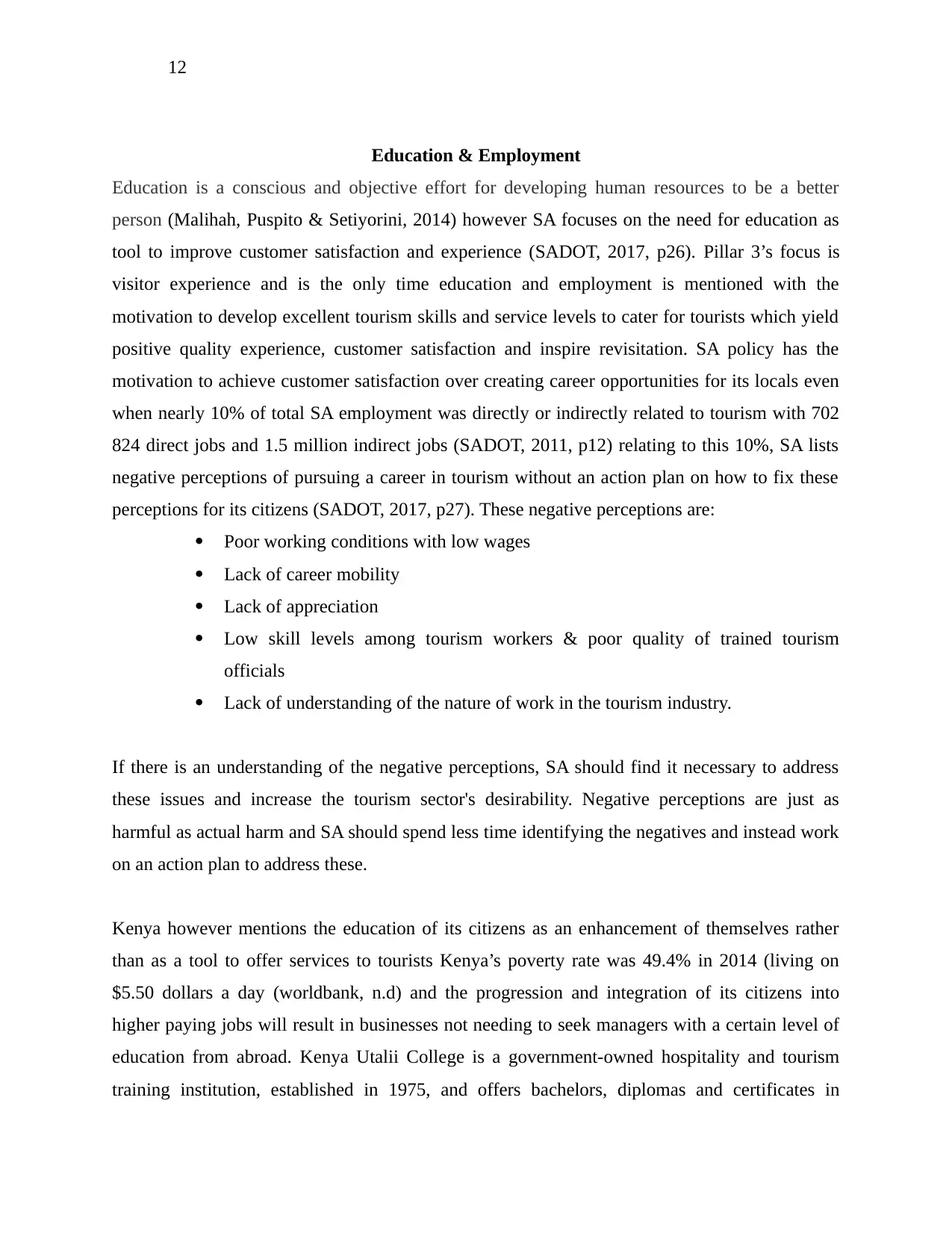
12
Education & Employment
Education is a conscious and objective effort for developing human resources to be a better
person (Malihah, Puspito & Setiyorini, 2014) however SA focuses on the need for education as
tool to improve customer satisfaction and experience (SADOT, 2017, p26). Pillar 3’s focus is
visitor experience and is the only time education and employment is mentioned with the
motivation to develop excellent tourism skills and service levels to cater for tourists which yield
positive quality experience, customer satisfaction and inspire revisitation. SA policy has the
motivation to achieve customer satisfaction over creating career opportunities for its locals even
when nearly 10% of total SA employment was directly or indirectly related to tourism with 702
824 direct jobs and 1.5 million indirect jobs (SADOT, 2011, p12) relating to this 10%, SA lists
negative perceptions of pursuing a career in tourism without an action plan on how to fix these
perceptions for its citizens (SADOT, 2017, p27). These negative perceptions are:
Poor working conditions with low wages
Lack of career mobility
Lack of appreciation
Low skill levels among tourism workers & poor quality of trained tourism
officials
Lack of understanding of the nature of work in the tourism industry.
If there is an understanding of the negative perceptions, SA should find it necessary to address
these issues and increase the tourism sector's desirability. Negative perceptions are just as
harmful as actual harm and SA should spend less time identifying the negatives and instead work
on an action plan to address these.
Kenya however mentions the education of its citizens as an enhancement of themselves rather
than as a tool to offer services to tourists Kenya’s poverty rate was 49.4% in 2014 (living on
$5.50 dollars a day (worldbank, n.d) and the progression and integration of its citizens into
higher paying jobs will result in businesses not needing to seek managers with a certain level of
education from abroad. Kenya Utalii College is a government-owned hospitality and tourism
training institution, established in 1975, and offers bachelors, diplomas and certificates in
Education & Employment
Education is a conscious and objective effort for developing human resources to be a better
person (Malihah, Puspito & Setiyorini, 2014) however SA focuses on the need for education as
tool to improve customer satisfaction and experience (SADOT, 2017, p26). Pillar 3’s focus is
visitor experience and is the only time education and employment is mentioned with the
motivation to develop excellent tourism skills and service levels to cater for tourists which yield
positive quality experience, customer satisfaction and inspire revisitation. SA policy has the
motivation to achieve customer satisfaction over creating career opportunities for its locals even
when nearly 10% of total SA employment was directly or indirectly related to tourism with 702
824 direct jobs and 1.5 million indirect jobs (SADOT, 2011, p12) relating to this 10%, SA lists
negative perceptions of pursuing a career in tourism without an action plan on how to fix these
perceptions for its citizens (SADOT, 2017, p27). These negative perceptions are:
Poor working conditions with low wages
Lack of career mobility
Lack of appreciation
Low skill levels among tourism workers & poor quality of trained tourism
officials
Lack of understanding of the nature of work in the tourism industry.
If there is an understanding of the negative perceptions, SA should find it necessary to address
these issues and increase the tourism sector's desirability. Negative perceptions are just as
harmful as actual harm and SA should spend less time identifying the negatives and instead work
on an action plan to address these.
Kenya however mentions the education of its citizens as an enhancement of themselves rather
than as a tool to offer services to tourists Kenya’s poverty rate was 49.4% in 2014 (living on
$5.50 dollars a day (worldbank, n.d) and the progression and integration of its citizens into
higher paying jobs will result in businesses not needing to seek managers with a certain level of
education from abroad. Kenya Utalii College is a government-owned hospitality and tourism
training institution, established in 1975, and offers bachelors, diplomas and certificates in
⊘ This is a preview!⊘
Do you want full access?
Subscribe today to unlock all pages.

Trusted by 1+ million students worldwide
1 out of 25
Related Documents
Your All-in-One AI-Powered Toolkit for Academic Success.
+13062052269
info@desklib.com
Available 24*7 on WhatsApp / Email
![[object Object]](/_next/static/media/star-bottom.7253800d.svg)
Unlock your academic potential
Copyright © 2020–2025 A2Z Services. All Rights Reserved. Developed and managed by ZUCOL.





